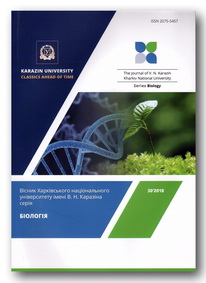Effect of the plant growth stimulant zeatin on regeneration capacity of some Physalis species in vitro culture
Abstract
The aim of the study was to find an efficient culture medium for regeneration of Physalis species in vitro to provide their further propagation ex vitro and obtain fructiferous plants from the regenerants. Physalis peruviana L., P. ixocarpa Broth. (cv. Likhtaryk), and P. pubescens L. (cv. Zarynka) were taken as plant material for the research. Plant introduction into culture and regenerant production were carried out in vitro; the rooting of mature plants and obtaining plants with ripe fruits took place in a greenhouse and in open ground (ex vitro). To obtain regenerants, we used Murashige and Skoog (MC30) medium supplemented with the growth stimulant zeatin (Zea) at a concentration of 0.5–3 mg/l. The growth stimulant 6-benzylaminopurine (BAP) was used to elongate the regenerant stalks, and the growth stimulator α-naphthylacetic acid (NAA) was used to initiate root formation. Plant regeneration frequency and the number of regenerants per explant served as indicators of the efficiency of various zeatin concentrations on the physalis regenerative capacity. The most effective media for the shoot regeneration from cotyledonous leaf explants were MC30 + 1 mg/l Zea and MC30 + 2 mg/l Zea. Regeneration frequency on these media was 46.15 % and 53.84 % for P. ixocarpa (cv. Likhtaryk), 38.46 % and 45 % for P. peruviana, and 27 % and 34 % for P. pubescens (cv. Zarynka) respectively. The emerged regenerants were separated from explants and transferred to MC30 medium supplemented with 1 mg/l of BAP + 0.1 mg/l of NAA for stalk growth and rooting. After a month of cultivation, juvenile plants were obtained. They were transferred to a greenhouse for adaptation, and later to open ground at the experimental plot. Three months after the regenerant emergence, we obtained fertile plants, which bloomed and bore fruit. The regenerants for domestic varieties of P. ixocarpa (cv. Likhtaryk) and P. pubescens (cv. Zarynka) were obtained for the first time. We established a direct relationship between the concentration of zeatin and both the frequency of plant regeneration and the number of regenerants per explant.
Downloads
References
Afroz F., Sayeed Hassan A.K.M., Shamroze Bari L. et al. (2009). In vitro shoot proliferation and plant regeneration of Physalis minima L. – a perennial medicinal herb. Bangladesh J. Sci. Ind. Res., 44(4), 453–456. https://doi.org/10.3329/bjsir.v44i4.4597
Assad-García N., Ochoa-Alejo N., García-Hernández E. et al. (1992). Agrobacterium-mediated transformation of tomatillo (Physalis ixocarpa) and tissue specific and developmental expression of the CaMV 35S promoter in transgenic tomatillo plants. Plant Cell Reports, 11, 558–562. https://doi.org/10.1007/BF00233092
Bergier K., Kuźniak E., Skłodowska M. (2012). Antioxidant potential of Agrobacterium-transformed and non-transformed Physalis ixocarpa plants grown in vitro and ex vitro. Postepy higieny i medycyny doswiadczalnej (Online), 66, 976–982. https://doi.org/10.5604/17322693.1023086
Gupta P.P. (1986). Regeneration of plants from mesophyll protoplasts of ground berry (Physalis minima L.). Plant Sci., 43, 151–154.
Kumar O., Ramesh S., Tata S. (2015). Establishment of a rapid plant regeneration system in Physalis angulata L. through axillary meristems. Notulae Scientia Biologicae, 7(4), 471–474. https://doi.org/10.15835/nsb749707
Lemmon Z.H., Reem N.T., Dalrymple J. et al. (2018). Rapid improvement of domestication traits in an orphan crop by genome editing. Nature Plants, 4, 766–770. https://doi.org/10.1038/s41477-018-0259-x
Mungole A.J., Doifode V.D., Kamble R.B. et al. (2011). In vitro callus induction and shoot regeneration in Physalis minima L. Annals of Biological Research, 2(2), 79–85.
Murashige T., Skoog F. (1962). A revised medium for rapid growth and bioassays with tobacco tissue cultures, Physiol. Plantarum, 15, 473–497. https://dx.doi.org/10.1111/j.1399-3054.1962.tb08052.x
Otroshy M., Mokhtari A., Khodaee S.M.M., Bazrafshan A.-H. (2013). Direct regeneration from leaves and nodes explants of Physalis peruviana L. Intl J Farm & Alli Sci., 2(9), 214–218.
Patel G.K., Bapat V.A., Rao P.S. (1987). Protoplast culture and genetic transformation in Physalis minima L. Proc. Indian Acad. Sci. (Plant Sci.), 97(4), 333–335.
Rakhmetov D.B., Korablyova O.A., Stadnichuk N.O. et al. (2015). Catalog of plants of the department of new crops: NAS of Ukraine, M.M. Gryshko National Botanical Garden. Kyiv: Phytosociocenter, 112 p. (In Ukrainian)
Ramar K., Ayyadurai V. (2014). In vitro regeneration of Physalis maxima (Mill) an important medicinal plant. Int. J. Curr. Microbiol. App. Sci., 3(12), 253–258.
Ramar K., Ayyadurai V., Arulprakash T. (2014). In vitro shoot multiplication and plant regeneration of Physalis peruviana L. an important medicinal plant. Int. J. Curr. Microbiol. App. Sci., 3(3), 456–464.
Rao Y.V., Shankar A.R., Lakshmi T.V., Rao K.R. (2004). Plant regeneration in Physalis pubescens L. and its induced mutant. Plant Tissue Cult., 14(1), 9–15.
Sandhya H., Srinath R. (2015). Role of growth regulators on in vitro callus induction and direct regeneration in Physalis minima Linn. International Letters of Natural Sciences, 44, 38–44. https://doi:10.18052/www.scipress.com/ILNS.44.38
Sheeba E., Palanivel S., Parvathi S. (2015). In vitro flowering and rapid propagation of Physalis minima Linn. – a medicinal plant. International Journal of Innovative Research in Science, Engineering and Technology, 4(1), 18763–18768. https://doi:10.15680/IJIRSET.2015.0401057
Singh P., Singh S.P., Shalitra R. et al. (2016). In vitro regeneration of cape gooseberry (Physalis peruviana L.) through nodal segment. The Bioscan, 11(1), 41–44. https://doi:10.13140/RG.2.2.13622.50241
Swartwood K., Van Eck J. (2019). Development of plant regeneration and Agrobacterium tumefaciens-mediated transformation methodology for Physalis pruinosa. Plant Cell Tiss Organ Cult, 137, 465–472. https://doi.org/10.1007/s11240-019-01582-x
Yaroshko O., Kuchuk M. (2019). Direct plant regeneration from Physalis peruviana L. explants. Biotechnologia Acta, 12(2), 56–52. https://doi.org/10.15407/biotech12.02.056
Authors retain copyright of their work and grant the journal the right of its first publication under the terms of the Creative Commons Attribution License 4.0 International (CC BY 4.0), that allows others to share the work with an acknowledgement of the work's authorship.




